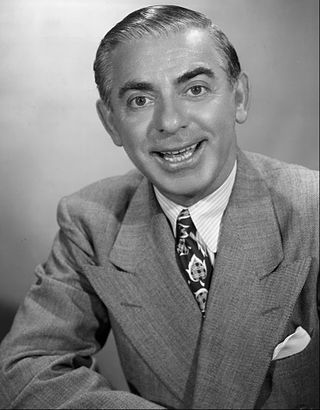
Eddie Cantor was an American comedian, actor, dancer, singer, songwriter, film producer, screenwriter and author. Familiar to Broadway, radio, movie, and early television audiences, this "Apostle of Pep" was regarded almost as a family member by millions because his top-rated radio shows revealed intimate stories and amusing anecdotes about his wife, Ida, and five daughters. Some of his hits include "Makin' Whoopee", "Ida ", "If You Knew Susie", "Ma! He's Making Eyes at Me", “Mandy”, "My Baby Just Cares for Me”, "Margie", and "How Ya Gonna Keep 'em Down on the Farm ?" He also wrote a few songs, including "Merrily We Roll Along", the Merrie Melodies Warner Bros. cartoon theme.

The Ziegfeld Follies were a series of elaborate theatrical revue productions on Broadway in New York City from 1907 to 1931, with renewals in 1934, 1936, 1943, and 1957. They became a radio program in 1932 and 1936 as The Ziegfeld Follies of the Air.

Mary William Ethelbert Appleton Burke was an American actress who was famous on Broadway and radio, and in silent and sound films. She is best known to modern audiences as Glinda the Good Witch of the North in the Metro-Goldwyn-Mayer movie musical The Wizard of Oz (1939).
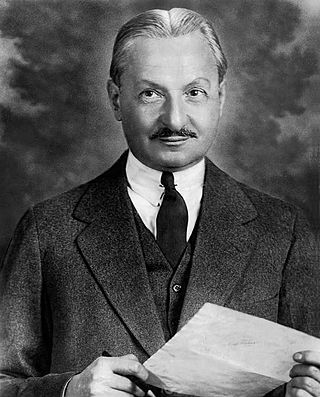
Florenz Edward Ziegfeld Jr. was an American Broadway impresario, notable for his series of theatrical revues, the Ziegfeld Follies (1907–1931), inspired by the Folies Bergère of Paris. He also produced the musical Show Boat. He was known as the "glorifier of the American girl". Ziegfeld is a member of the American Theater Hall of Fame.
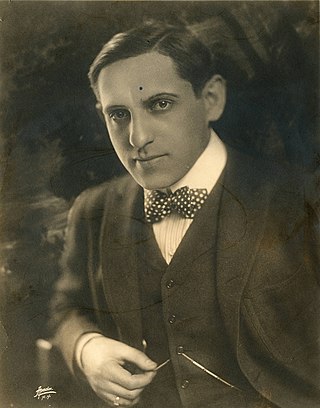
Gustave Edwards was an American composer, songwriter and film director. He also was a vaudevillian, organised his own theatre companies and was a music publisher.

The Will Rogers Follies is a musical with a book by Peter Stone, lyrics by Betty Comden and Adolph Green, and music by Cy Coleman.
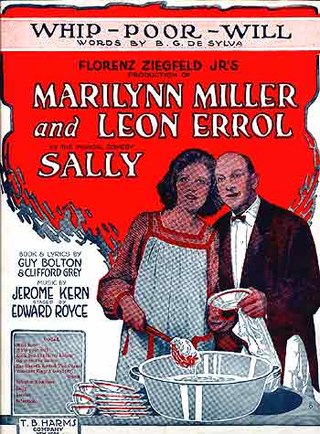
Sally is a musical comedy with music by Jerome Kern, lyrics by Clifford Grey and book by Guy Bolton, with additional lyrics by Buddy De Sylva, Anne Caldwell and P. G. Wodehouse. The plot hinges on a mistaken identity: Sally, a waif, is a dishwasher at the Alley Inn in New York City. She poses as a famous foreign ballerina and rises to fame through joining the Ziegfeld Follies. There is a rags to riches story, a ballet as a centrepiece, and a wedding as a finale. "Look for the Silver Lining" continues to be one of Kern's most familiar songs. The song is lampooned by another song, "Look for a Sky of Blue," in Rick Besoyan's satirical 1959 musical Little Mary Sunshine.

Marilyn Miller was one of the most popular Broadway musical stars of the 1920s and early 1930s. She was an accomplished tap dancer, singer and actress, and the combination of these talents endeared her to audiences. On stage, she usually played rags-to-riches Cinderella characters who lived happily ever after. Her enormous popularity and famed image were in distinct contrast to her personal life, which was marred by disappointment, tragedy, frequent illness, and ultimately her sudden death due to complications of nasal surgery at age 37.
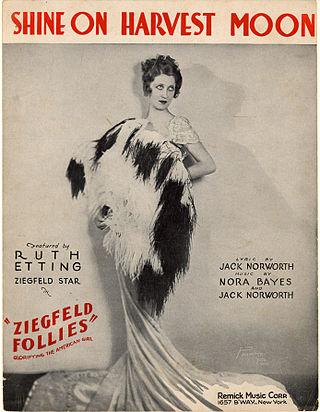
Ziegfeld Girls were the actresses, singers, chorus girls, showgirls and other female performers who appeared in Florenz Ziegfeld's theatrical Broadway revue spectaculars known as the Ziegfeld Follies, produced in New York City. The revues were originally based on the Folies Bergère of Paris. Ziegfeld girls also included female performers who participated in the Ziegfeld Midnight Frolic and the Ziegfeld 9 O'Clock Revue (1919-1920).
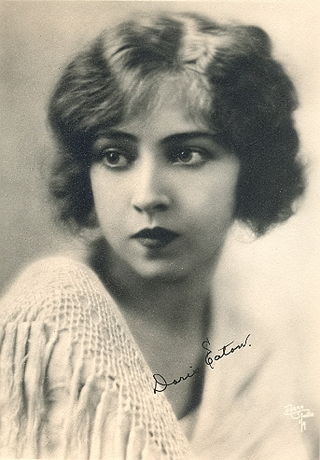
Doris Eaton Travis was an American dancer, stage and film actress, dance instructor, owner and manager, writer, and rancher, who was the last surviving Ziegfeld Girl, a troupe of acclaimed chorus girls who performed as members in the Broadway theatrical revues of the Ziegfeld Follies.
Will Vodery was an American composer, conductor, orchestrator, and arranger, and one of the few black Americans of his time to make a name for himself as a composer on Broadway, working largely for Florenz Ziegfeld. He had offices at the Gaiety Theatre office building in Times Square.

Anna Pennington was an American actress, dancer, and singer who starred on Broadway in the 1910s and 1920s, notably in the Ziegfeld Follies and George White's Scandals.
London Calling! was a musical revue, produced by André Charlot with music and lyrics by Noël Coward, which opened at London's Duke of York's Theatre on 4 September 1923. It is famous for being Noël Coward's first publicly produced musical work and for the use of a 3-D stereoscopic shadowgraph as part of its opening act. The revue's song "Parisian Pierrot", sung by Gertrude Lawrence, was Coward's first big hit and became one of his signature tunes.

The Passing Show was a musical revue in three acts, billed as a "topical extravaganza", with a book and lyrics by Sydney Rosenfeld and music by Ludwig Engländer and various other composers. It featured spoofs of theatrical productions of the past season. The show was presented in 1894 by George Lederer at the Casino Theatre. It was one of the first musical revues on Broadway and led the fashion for such productions. The Casino Theatre produced a revue each summer thereafter for several seasons.

"A Pretty Girl Is Like A Melody" is a popular song written by Irving Berlin in 1919 which became the theme song of the Ziegfeld Follies. The first verse and refrain are considered part of the Great American Songbook and are often covered as a jazz standard.

George White was an American theatrical and film producer and director who also was an actor, choreographer, composer, dancer, dramatist, lyricist and screenwriter, as well as a Broadway theater owner.

Noel Francis was an American actress of the stage and screen during the 1920s and 1930s. Born in Texas, she began her acting career on the Broadway stage in the mid-1920s, before moving to Hollywood at the beginning of the sound film era.

The Earl Carroll Vanities was a Broadway revue presented by Earl Carroll in the 1920s and early 1930s. Carroll and his show were sometimes controversial.

Nora Bayes was an American singer and vaudeville performer who was popular internationally between the 1900s and 1920s. She is credited with co-writing the song "Shine On, Harvest Moon" and performed many successful songs during the First World War, including "Over There." She was also noted for her independent views and unconventional private life, becoming an early media celebrity. She made over 160 recordings.
The Follies of 1907 is a 1907 musical revue which was conceived and produced by Florenz Ziegfeld Jr. The first of several theatrical revues that are collectively known as the "Ziegfeld Follies", the work contained songs material written by a variety of individuals; including music by Seymour Furth, E. Ray Goetz, Gus Edwards, Billy Gaston, Jean Schwartz, Silvio Hein, Matt Woodward and Gertrude Hoffman; and lyrics by Vincent Bryan, Edgar Selden, Will D. Cobb, Billy Gaston, William Jerome, Matt Woodward, Martin Brown and Paul West. Harry B. Smith authored the words for the comedic and dramatic sketches used in-between the musical numbers; as well as serving as head lyricist. Herbert Gresham staged the production and Max Hoffman, Sr. served as the musical director.

















